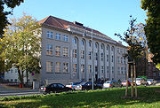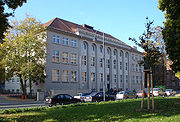
Optical Museum Jena
Encyclopedia

Jena
Jena is a university city in central Germany on the river Saale. It has a population of approx. 103,000 and is the second largest city in the federal state of Thuringia, after Erfurt.-History:Jena was first mentioned in an 1182 document...
is a scientific-technological museum.
The Optical Museum Jena shows optical instruments from eight centuries. It gives a technical and cultural-historical survey of the development of optical instruments. The development of the city Jena to the centre of the optical industries since the mid-19th-century is integrated in the exhibition, connected with the lifeworks of Ernst Abbe, Carl Zeiss
Carl Zeiss
Carl Zeiss was a German maker of optical instruments commonly known for the company he founded, Carl Zeiss Jena . Zeiss made contributions to lens manufacturing that have aided the modern production of lenses...
and Otto Schott.
In cooperation with the art club Jena non-optical themes are offered in special exhibitions.
The Optical Museum Jena is the only museum of its kind in Germany
Germany
Germany , officially the Federal Republic of Germany , is a federal parliamentary republic in Europe. The country consists of 16 states while the capital and largest city is Berlin. Germany covers an area of 357,021 km2 and has a largely temperate seasonal climate...
.
History
Besides the production of microscopes, Carl Zeiss took over repairing optical instruments of other manufacturers. He did this to pursue the rivalries development. At the turn from 19th to the 20th century, the staff of the Carl Zeiss company began to collect optical instruments.In June 1922, the Carl-Zeiss-Stiftung
Carl-Zeiss-Stiftung
The Carl-Zeiss-Stiftung , located in Heidenheim an der Brenz and Jena, Germany, is the sole shareholder of the two companies Carl Zeiss AG and Schott AG. It was founded by Ernst Abbe and named after his long-term partner Carl Zeiss...
established the Optical Museum; the exhibition was located in the neighbouring Volkshaus (community hall). Johannes Schreiter and Hans Schlag designed a building for the 1917 founded "college of ophthalmology". The reinforced concrete construction was carried out during 1923/24 by the company Dyckerhoff & Widmann (DYWIDAG) from Nuremberg. In October 1924, the exhibition was moved into the new building at no. 12 Carl-Zeiss-Platz in which it is still housed today. The collections were reserved for a selected group of people for purposes of research and not open to the public.
During the Second World War
World War II
World War II, or the Second World War , was a global conflict lasting from 1939 to 1945, involving most of the world's nations—including all of the great powers—eventually forming two opposing military alliances: the Allies and the Axis...
in 1941/42, the exhibition was relocated to underground production facilities around Jena. The Optical Museum was preserved from the Soviet occupation's dismantling programme 1946. The first permanent exhibition was launched 1965 in the Griesbach Garden House. In 1976/77, the exhibition was returned to the building at no. 12 Carl-Zeiss-Platz. On the occasion of the 100th anniversary of the death of Carl Zeiss in December 1988, the historical Zeiss-Workshop (circa 1860) was opened as part of the Optical Museum in the neighboured Volkshaus.
Accompanied with the opening, the museum was renamed as the "Zeiss-Museum" but the name was changed back in 1991. In June 1992, the Optical Museum was taken into the trusteeship of the newly-established Ernst-Abbe-Foundation. The historical Zeiss-Workshop was moved in 2002 from the Volkshaus to the Optical Museum.
Ground
- History of glassesGlassesGlasses, also known as eyeglasses , spectacles or simply specs , are frames bearing lenses worn in front of the eyes. They are normally used for vision correction or eye protection. Safety glasses are a kind of eye protection against flying debris or against visible and near visible light or...
- Historical development of microscopyMicroscopyMicroscopy is the technical field of using microscopes to view samples and objects that cannot be seen with the unaided eye...
- TelescopeTelescopeA telescope is an instrument that aids in the observation of remote objects by collecting electromagnetic radiation . The first known practical telescopes were invented in the Netherlands at the beginning of the 1600s , using glass lenses...
s and their masters - History of photographyTimeline of photography technologyTimeline of photography technology* 1822 – Nicéphore Niépce takes the first fixed, permanent photograph, of an engraving of Pope Pius VII, using a non-lens contact-printing "heliographic process", but it was destroyed later; the earliest surviving example is from 1825.* 1826 – Nicéphore Niépce...
- World of images: camera obscuraCamera obscuraThe camera obscura is an optical device that projects an image of its surroundings on a screen. It is used in drawing and for entertainment, and was one of the inventions that led to photography. The device consists of a box or room with a hole in one side...
, peep showPeep showA peep show or peepshow is an exhibition of pictures, objects or people viewed through a small hole or magnifying glass. Though historically a peep show was a form of entertainment provided by wandering showmen, nowadays it more commonly refers a presentation of a sex show or pornographic film...
s and magic lanternMagic lanternThe magic lantern or Laterna Magica is an early type of image projector developed in the 17th century.-Operation:The magic lantern has a concave mirror in front of a light source that gathers light and projects it through a slide with an image scanned onto it. The light rays cross an aperture , and...
s - OphthalmologicalOphthalmologyOphthalmology is the branch of medicine that deals with the anatomy, physiology and diseases of the eye. An ophthalmologist is a specialist in medical and surgical eye problems...
instruments - Carl Zeiss: life and work
- Ernst Abbe
- Otto Schott
Basement
- Historical Zeiss-Workshop 1860
- HolographHolographA holograph is a document written entirely in the handwriting of the person whose signature it bears. Some countries or local jurisdictions within certain countries give legal standing to specific types of holographic documents, generally waiving requirements that they be witnessed...
-collection - ColorColorColor or colour is the visual perceptual property corresponding in humans to the categories called red, green, blue and others. Color derives from the spectrum of light interacting in the eye with the spectral sensitivities of the light receptors...
s - Milestones of optics (optical lab for classes)

